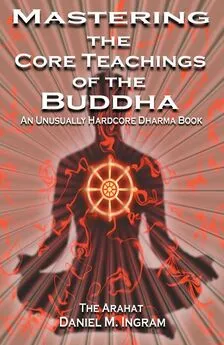Daniel Ingram - Mastering the Core Teachings of Buddha - An Unusually Hardcore Dharma Book
- Название:Mastering the Core Teachings of Buddha - An Unusually Hardcore Dharma Book
- Автор:
- Жанр:
- Издательство:Aeon Books
- Год:2009
- ISBN:9781904658405
- Рейтинг:
- Избранное:Добавить в избранное
-
Отзывы:
-
Ваша оценка:
Daniel Ingram - Mastering the Core Teachings of Buddha - An Unusually Hardcore Dharma Book краткое содержание
Mastering the Core Teachings of Buddha - An Unusually Hardcore Dharma Book - читать онлайн бесплатно полную версию (весь текст целиком)
Интервал:
Закладка:
One more great thing about the first training is that it really helps with the next training: concentration. So, here's a tip: if you are finding it hard to concentrate because your mind is filled with guilt, judgment, envy or some other hard and difficult thought pattern, also work on the first training, kindness. It will be time well spent.
8
3.CONCENTRATION, THE SECOND TRAINING
On to concentration, the ability to steady the mind on whatever you wish and attain unusual and profound altered states of consciousness.
Training in concentration relates to formal meditation practice. It is also called training in “samadhi” (meaning depths of meditation), or sometimes “samatha practice.” Concentration practice involves working at a level that might be considered unusual, particularly contrasted with the ordinary level of training in morality. Training in morality is something to which everyone can relate. Training in concentration is only easy to relate to if you have attained to unusual states of consciousness or at least have faith that they can be attained.
Training in concentration has had thousands of pages dedicated to it, and there are probably thousands of concentration exercises. Some very commonly used objects of meditation are the breath (my personal favorite), one’s posture, a mantra or koan, a candle flame, various visualization exercises, and even the experience of concentration itself.
The object you choose should be one on which you would be happy to steady your mind.
The essential point about meditation is this: to get anywhere in meditation you need to be able to really steady the mind and be present.
That's just all there is to it and it is largely a question of just doing it.
There is an important shift that happens in people's practice when they really make the commitment to developing concentration and follow through with it. Until one does this, not much is likely to happen in one’s meditative practice! If you decide to do a concentration practice, stay on that object like a rabid dog until you have enough stability and skill to let the mind rest on it naturally.
The first formal goal when training in concentration is to attain something called “access concentration,” meaning the ability to stay consistently with your chosen object with relative ease to the general exclusion of distractions. This is the basic attainment that allows you to access the higher stages of concentration and also to begin the path of insight (the third training), so make attaining access concentration your first goal in your meditative practice. You will know when you have it.
So, the essential formal concentration practice instructions are: pick an object (the list above is a great place to begin), find a place to practice
Concentration, The Second TrainingMorality, The First and Last Training
where you are as free from distractions as possible, pick a sustainable posture (it doesn’t really matter so much), focus your attention on the object as completely and consistently as possible for the duration of that practice period, allowing as few lapses in concentration as possible, and learn to stabilize all of your attention on that object. The more you practice and the better your practice, the better you will become. Find the balance of effort and steadiness that works for you. Practice again and again until you can attain access concentration. While this paragraph may seem trite or sparse, it contains the formal instructions on how to begin training in concentration.
Should you need someone to tell you how long to practice, start with 10 minutes a day and work up to an hour or two each day as your life allows. If you can learn to hold your attention completely on your chosen object for even one solid minute, you have some strong concentration skills. That said, you might have 10 hours a day to devote to practice. Don’t let me hold you back! How long it will take you to develop access concentration is dependent upon a number of factors including practice conditions, your natural and cultivated concentration ability, the strength of your drive to succeed, and how much you practice.
Sharpening your concentration may help almost everything you do, and can provide a mental and emotional stability that can be very useful.
Concentration can also lead to some very nice states called “jhanas” and other names. These can be extremely blissful and peaceful. Being able to access these states of mind can be ridiculously enjoyable and can increase steadiness and stability of mind. These are of value in and of themselves and also serve the important function in the Buddhist tradition of providing a disposable foundation for insight practices, i.e.
the third training.
I will leave off describing the high concentration attainments until Part III so as to keep this section focused on the essential skills necessary for meditation, as once you gain access concentration getting into those states is very easy. Until you can get into access concentration, you ain’t got squat. Thus, pick an object, practice well and often, learn to attain to access concentration, finish reading this book, and by that point everything should be very straightforward.
10
Concentration, The Second TrainingMorality, The First and Last Training
Now, it must be said that concentration practices, like all practices, have their shadow sides. For instance, high and unusual experiences can become addictive and seductive, causing them to receive more attention and focus than they deserve. They can also lead to people becoming very otherworldly and ungrounded, very much the way that
hallucinogens can. They can also bring up lots of our psychological
“stuff.” This last limitation could be a benefit if we are in a mood to deal with this stuff. Perhaps the most important limitations of concentration practices is that they do not lead directly to the insights and permanent understandings that come from training in wisdom, as much as we might like them to. That brings us to the third training…
11
4.WISDOM, THE THIRD TRAINING
The third training in the list is wisdom, in this case a very special kind of wisdom that I will often call “ultimate” or “fundamental”
wisdom. This may also be rendered as “understanding” or “insight.”
The whole trick to this training is to understand the truth of the sensations that make up our present experience. The great mystics from all traditions have reported that there is something remarkable and even enlightening about our ordinary experiences if we take the time to look into them very carefully. Those that undertake training in wisdom have decided to do the experiment and see for themselves if this is true or if those old dead dudes were just making it all up.
Obviously, the first assumption that must be made is that there is some understanding that is completely beyond any ordinary
understanding, even beyond the altered states of consciousness that can be attained if we train in concentration. The next assumption is that there are specific practices that can lead to that understanding if we simply do them. The third and perhaps most vital assumption is that we can do them and be successful.
The assumption that is rarely stated explicitly but often implied is that we must be willing to stay on a sensate level, at the level of the actual sensations that make up experiences, if we wish to gain the insights that are promised by the mystics. The corollary of this assumption is that we must be willing to set aside periods of time during which we abandon the ordinary way of working in the world that is called training in morality and even the unusual way of working with altered states of consciousness that is called training in concentration.
We assume that the teachings on wisdom point to universal truths, truths that can be perceived in all types of experience without exception.
We assume that if we can simply know our sensate experience clearly enough, then we will come to understand for ourselves.
The primary agenda for doing insight practices is to increase our perceptual abilities so that the truths mentioned by the great mystics become obvious to us. Thus, rather than caring what we think, say or do, or caring about what altered state of consciousness we are in, when training in wisdom we actively work to simply increase the speed, precision, consistency and inclusiveness of our experience of all the
Wisdom, The Third Training
quick little sensations that make up our experience, whatever and however they may be.
Thus, the esse
ntial formal insight meditation instructions are : find a
place where the distractions are tolerable, pick a stable and sustainable posture, and for a defined period of time notice every single sensation that makes up your reality as best you can. Just as with concentration practices, more time and more diligent practice pays off. These simple instructions can easily seem overwhelming, vague or strangely trivial to many people, and so I am going to spend a lot of time laying out a large number of empowering concepts and more structured practices that have helped countless practitioners over thousands of years to follow these basic instructions.
While the Three Trainings all contain some similar elements, there are some important contrasts that must be made between them. The gold standard for training in morality is how kind and compassionate our intentions are and how well we lead a useful and moral life. The gold standard for training in concentration practices is how quickly we can enter into highly altered states of consciousness, how long we can stay in them, and how refined, complete and stable we can make those states. The gold standard for insight practices is that we can quickly and consistently see the true nature of the numerous quick sensations that make up our whole reality, regardless of what those sensations are, allowing us to cut to a level of understanding that goes utterly beyond specific conditions.
It is absolutely vital that the differences between these gold standards be understood. Considered this way, these gold standards do not overlap and may even seem to contradict one another. This is a very practical assumption. As these differences seem to be extremely difficult to explain clearly, I will make this basic point again and again throughout this book.
So, having gained enough morality to be temporarily free of
excessive negative mind states and enough concentration to steady the mind somewhat, look into the bare truth of the sensations of this moment. This is called insight meditation and other names, and it is designed to produce wisdom.
13
Wisdom, The Third Training
Sounds simple, and while it is, it also isn't. There are many types of insight that we may derive from experiencing the world. Usually, we might think of training in wisdom as having to do with relative issues like how to live our lives. In this sense, one might just try to be wiser.
Perhaps we could skillfully reflect on something that went badly and see if perhaps in the future some wisdom gained from that experience might change the way we live our life. This is an ordinary form of wisdom, and so the insights we derive from such reflections and observations are insights into the ordinary world.
On the other hand, these sorts of reflections can only take us so far, and to really get what the Buddha was talking about, we need to go far beyond these conventional definitions of wisdom and attain to ultimate insights by doing insight practices. Many people try to make insight practices into an exercise that will produce both insights into the ordinary world and also ultimate insights. I have come to the conclusion that we should not count on ultimate teachings to illuminate our relative issues or vice versa, and so I feel that it is extremely important to keep the relative and ultimate wisdom teachings separate. Failure to do so causes endless problems and makes progress on either front more difficult rather than easier. Thus, I will revisit this topic again and again throughout this work, doing my best to clearly differentiate those practices that produce ordinary wisdom from those practices that fall within the third training and lead to ultimate realizations that are independent of our relative insights.
Читать дальшеИнтервал:
Закладка:





![Дженнифер Гюнтер - The vagina book. Главная книга для тех, у кого есть этот орган [litres]](/books/1061538/dzhennifer-gyunter-the-vagina-book-glavnaya-kniga-dl.webp)




